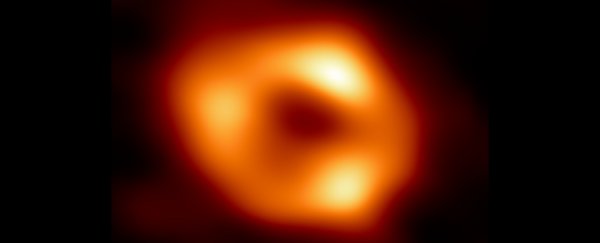Four and a half billion years ago, our pale blue dot was born in the rubble left over from the birth of a star. Since then, we've been locked in a cosmic dance; Earth whirls around the Sun; and the Sun whirls around the galactic center – the dark, mysterious heart of the Milky Way.
Contained in that dark heart, around which the entire galaxy revolves, is a supermassive black hole named Sagittarius A*, clocking in at roughly 4.3 million times the mass of the Sun. We've been able to infer its presence, and measure it, based on the movements of objects around it, but never had we seen the object itself.
Never, that is, until now.
That image at the top of the screen – looking like a glorious blurry orange donut – is the dust around and shadow of Sgr A* itself, seen by humanity for the very first time, thanks to the hard work of the Event Horizon Telescope collaboration.
"We were stunned by how well the size of the ring agreed with predictions from Einstein's theory of general relativity," said EHT Project Scientist Geoffrey Bower of Academia Sinica in Taipei.
"These unprecedented observations have greatly improved our understanding of what happens at the very center of our galaxy, and offer new insights on how these giant black holes interact with their surroundings."
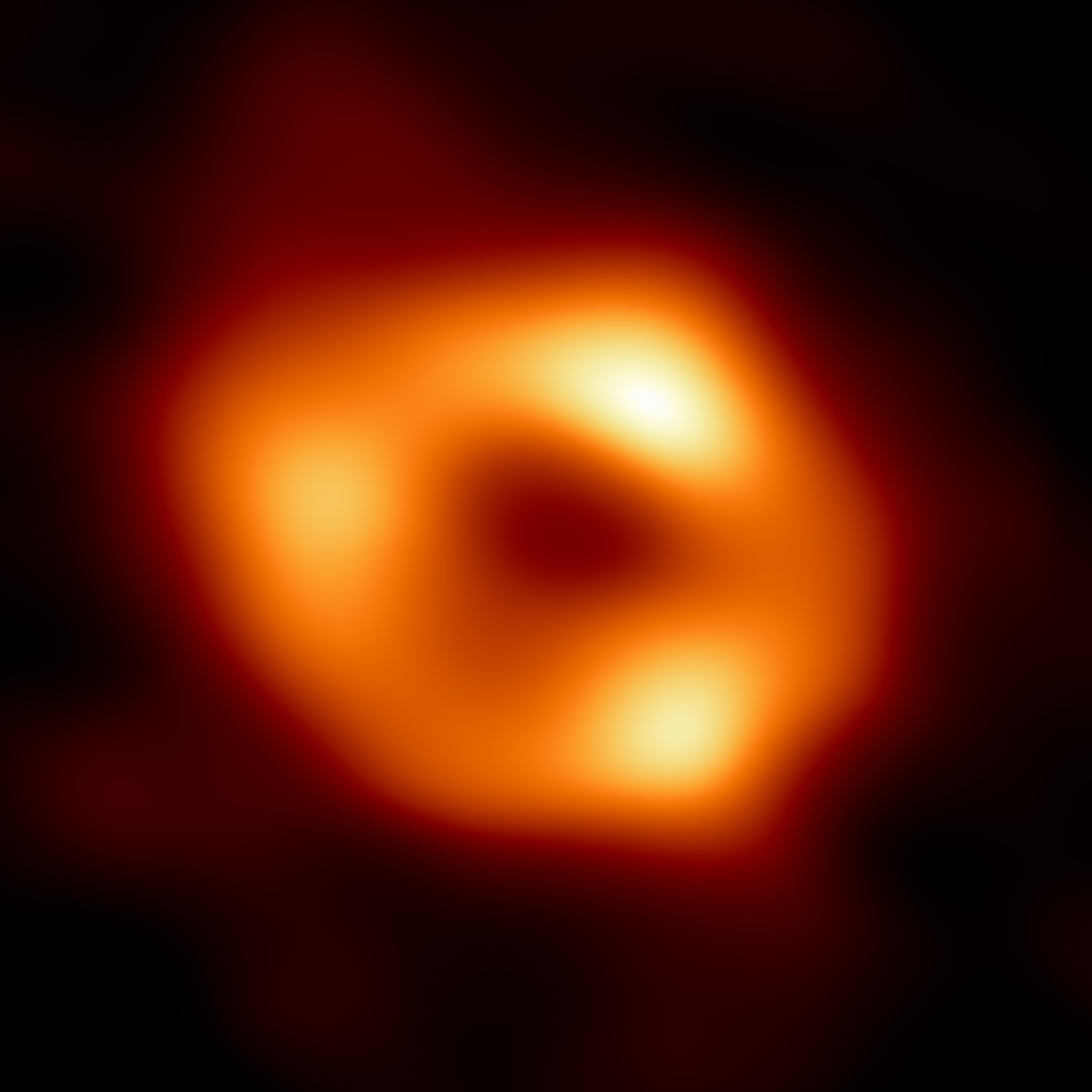 We can't stop staring. The first-ever image of Sgr A*. (EHT Collaboration)
We can't stop staring. The first-ever image of Sgr A*. (EHT Collaboration)
The achievement comes three years after the collaboration released the first image of a black hole's shadow ever obtained – a supermassive black hole named M87*, clocking in at 6.5 billion times the mass of the Sun, at the center of a galaxy 55 million light-years away.
Sgr A* is considerably closer to us, at a distance of around 25,800 light-years. But the two black holes presented very different challenges.
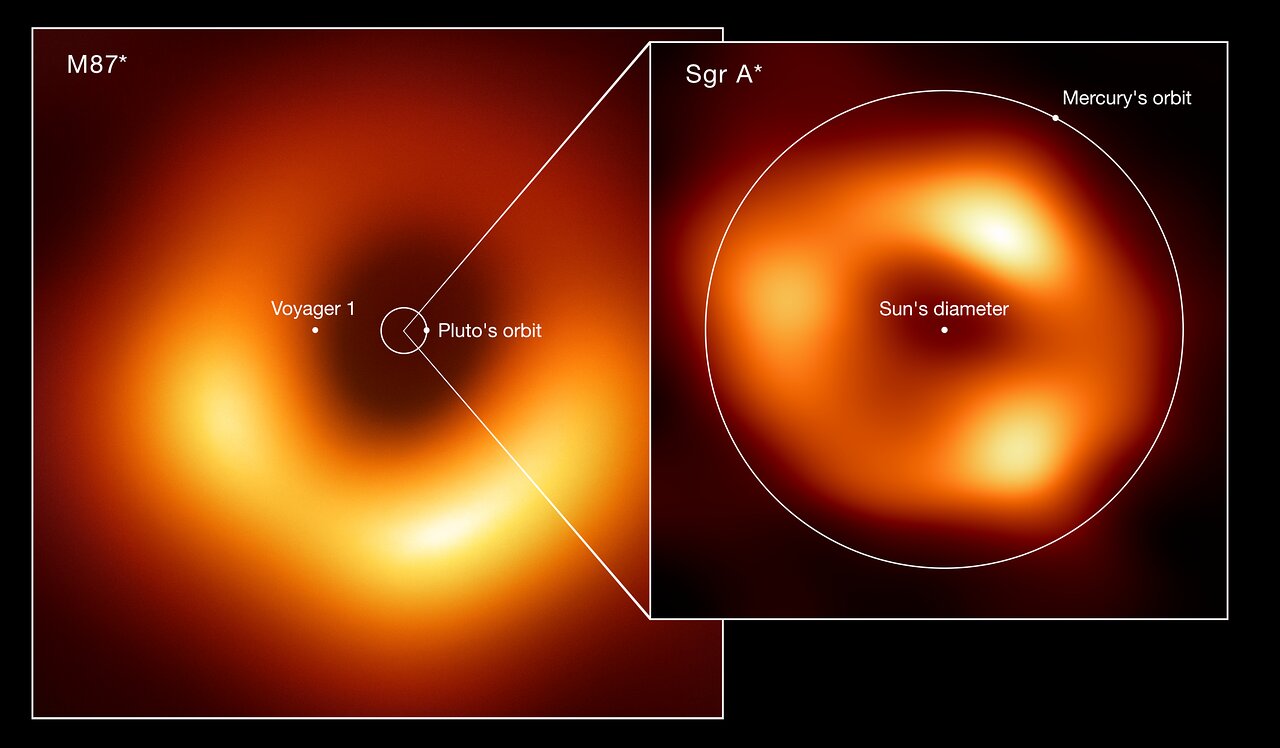 Size comparison of M87* and Sgr A*. (EHT collaboration, acknowledgment: Lia Medeiros, xkcd)
Size comparison of M87* and Sgr A*. (EHT collaboration, acknowledgment: Lia Medeiros, xkcd)
Attempting to image a black hole is attempting to image the invisible. Black holes give off no radiation we can detect. They're so dense that, past a certain point known as the event horizon, not even light, the fastest known thing in the Universe, is able to achieve escape velocity from their gravitational pull.
M87* is what we refer to as an active galactic nucleus. That means it's feeding – surrounded by an enormous disk of dust and gas that is getting pulled into the black hole. The insane friction and gravity involved heat up this material, so that it glows brightly. That's what we see in the picture of M87*, with the shadow of the black hole in the center of the glowing material.
Sagittarius A* may be closer… but it's nowhere near as active. In fact, if Sgr A* were a person, it would only consume the equivalent of a grain of rice every million years.
Moreover, the Milky Way galactic center is thick with dust that obscures much of what is contained therein.
Scientists had previously detected a cloud of gas orbiting Sgr A*, an accretion disk of the black hole's very own, but it's relatively cool and glowing much more faintly. Moreover, because the black hole is smaller, the disk's orbital period is smaller, which means the light changes on very rapid timescales.
"The gas in the vicinity of the black holes moves at the same speed – nearly as fast as light – around both Sgr A* and M87*," said astronomer Chi-kwan ('CK') Chan of the University of Arizona.
"But where gas takes days to weeks to orbit the larger M87*, in the much smaller Sgr A* it completes an orbit in mere minutes. This means the brightness and pattern of the gas around Sgr A* was changing rapidly as the EHT Collaboration was observing it – a bit like trying to take a clear picture of a puppy quickly chasing its tail."
Within, something shines brightly in radio wavelengths – that would be Sgr A*, but we'd never been able to obtain a detailed view of it.
To overcome these challenges, the Event Horizon Telescope combined eight telescopes from around the world, which worked together in what is essentially an Earth-sized telescope, with spectacular resolution.
A large number of images were taken during an observing campaign in 2017, producing six terabytes of data. These data had to be processed and analyzed – a process that took years, and the development of new algorithms to compensate for the rapid changeability.
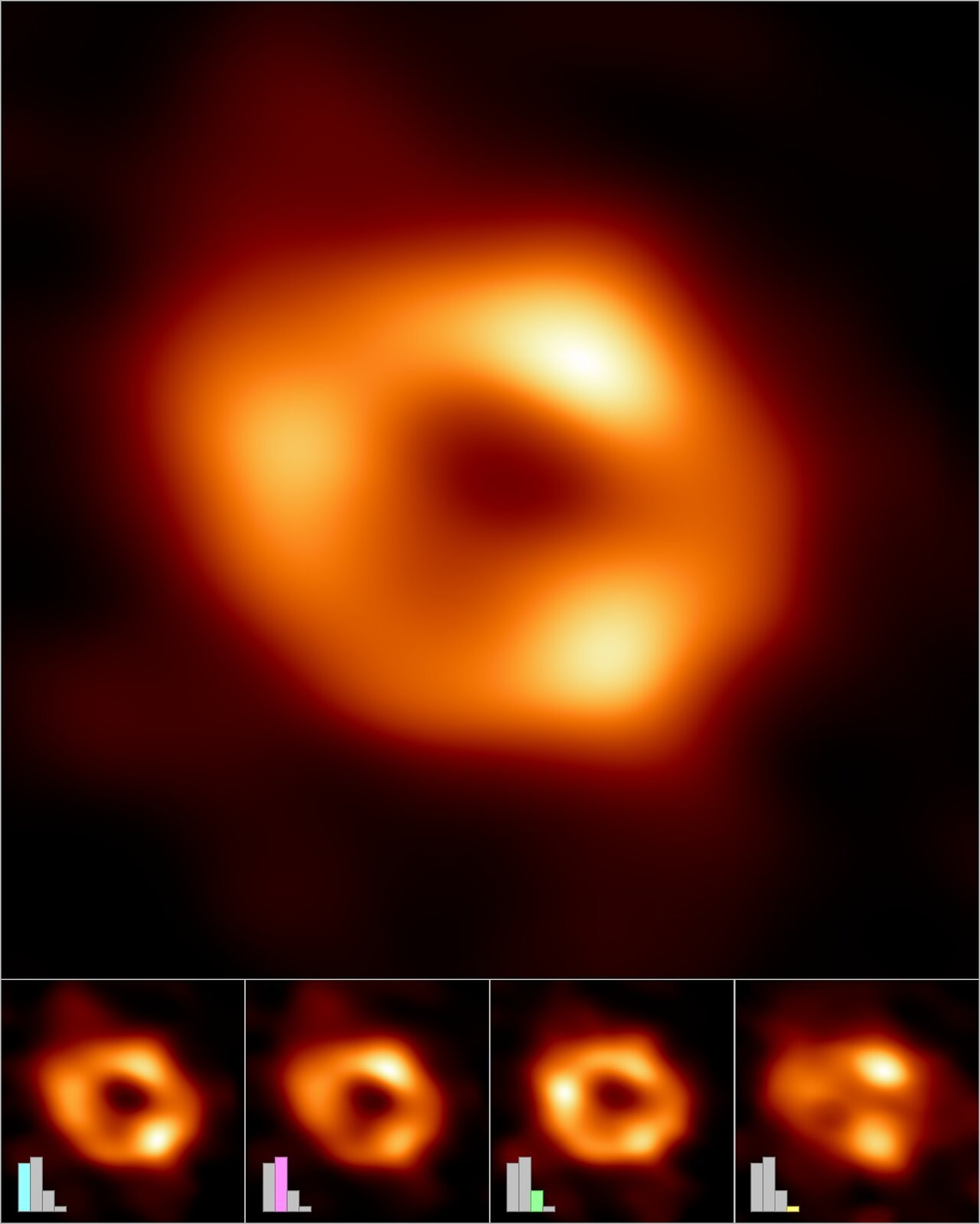 (EHT Collaboration)
(EHT Collaboration)
Above: The EHT Collaboration created the first-ever image (top frame) of Sgr A* by averaging together thousands of images created using different computational methods – all of which accurately fit the EHT data. This averaged image retains features more commonly seen in the varied images and suppresses features that appear infrequently.
The images were grouped into four classes based on similar features, which you can see at the bottom of the image above. The bar graphs show the relative number of images belonging to each cluster.
Scientists are going to be chewing over the incredible results for some time to come.
Supermassive black holes are a cosmic mystery. We don't know how they manage to get so big – Sgr A* is actually pretty tiny for one of these behemoths – or how they formed in the first place, at the dawn of time. They are, however, major drivers in the evolution of the cosmos. Entire galaxies swirl around them; they control star formation, even outside their own galaxies.
The supermassive black holes that we usually study are active, like M87*. That's because the material in the space around them emits light, and the magnetic fields of the black holes can accelerate jets into intergalactic space, both of which can tell us about the black hole itself.
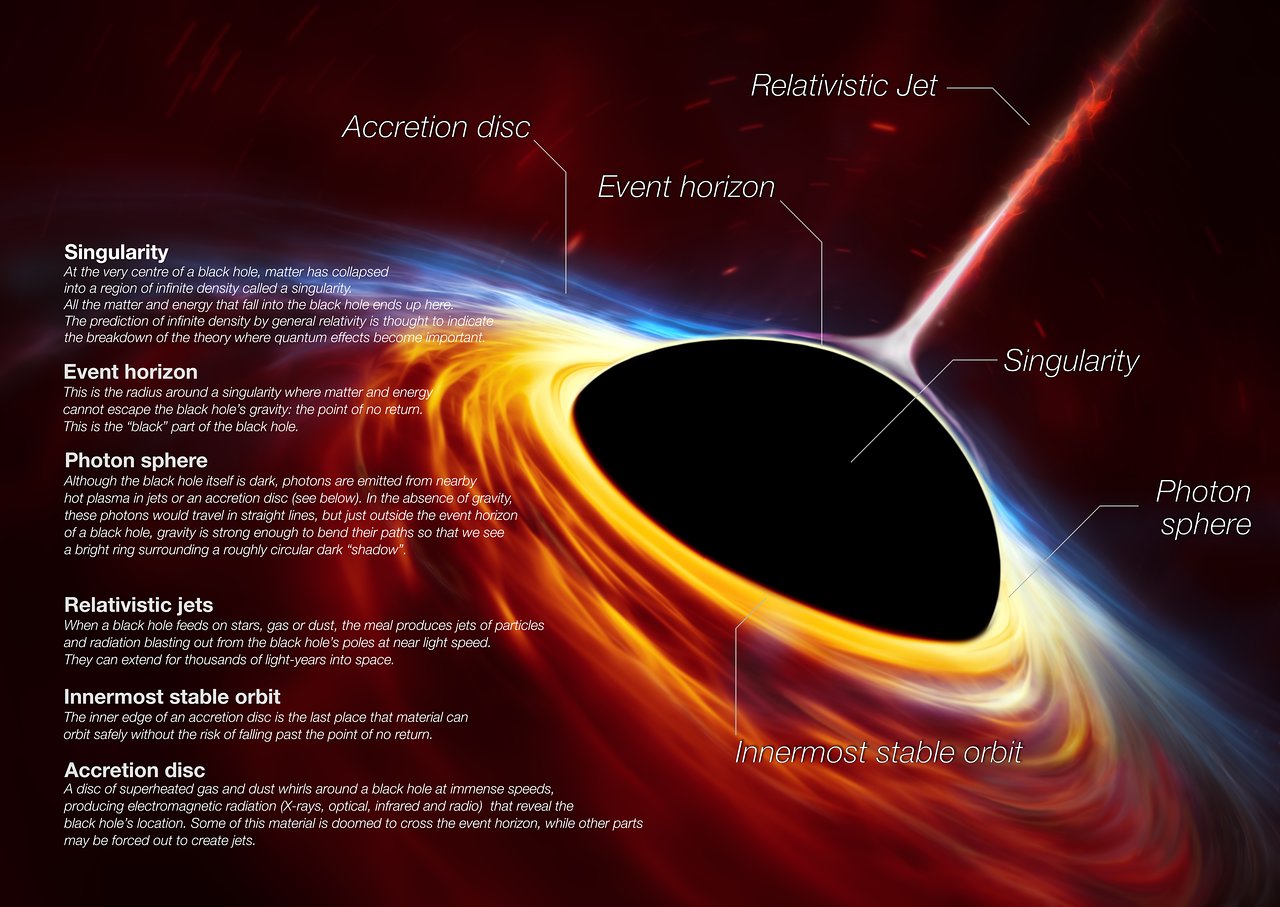 Illustration showing the anatomy of a supermassive black hole. (ESO)
Illustration showing the anatomy of a supermassive black hole. (ESO)
Sgr A*'s quiescence may have made it more challenging to image, but that very characteristic makes it extraordinary as an object of study. Because it's not blazing with light like a more active black hole, we might be able to see the environment around it a little more clearly, which in turn might give us a better window into event horizon physics.
This could help us understand all sorts of black hole mysteries, such as how accretion works, how jets are launched, even whether general relativity has accurately described the extreme space-time in the vicinity of a black hole.
Fascinatingly, the two black holes appear very similar. This, the researchers said, means we can make certain inferences about black holes.
"We have two completely different types of galaxies and two very different black hole masses, but close to the edge of these black holes they look amazingly similar," said astronomer Sera Markoff of the EHT Science Council at the University of Amsterdam in the Netherlands.
"This tells us that general relativity governs these objects up close, and any differences we see further away must be due to differences in the material that surrounds the black holes."
The new image opens up a new door for studying these extreme objects. One image of a black hole is amazing. Two means that not only was that first result real, we now have a point of comparison to understand how these incredible, extreme objects operate.
"Now we can study the differences between these two supermassive black holes to gain valuable new clues about how this important process works," said astrophysicist Keiichi Asada of Academia Sinica.
"We have images for two black holes – one at the large end and one at the small end of supermassive black holes in the Universe – so we can go a lot further in testing how gravity behaves in these extreme environments than ever before."
The new results have been published in a special issue of The Astrophysical Journal Letters.
You can watch the press conference below, and see our (now finished) live blog, where we covered the announcement in real time.
All times below are in UTC and chronological order. Refresh and scroll to the bottom to see the latest updates. We'll be adding new information every few minutes.
12.40: Okay, the moment has arrived! We're on the edge of our seats and immensely excited to share this huge moment in astronomy with all of you. We'll be updating this blog every few minutes so keep hitting refresh!
12.41: For those who are catching up, here's what we know so far about the announcement. Results are from the EHT, which gave us our first image of a black hole almost three years ago. We also know the results concern our own Milky Way… which suggests that perhaps we're about to see the very first image of the supermassive black hole at the center of our galaxy, Sagittarius A* (Sgr A*).
If astronomers have managed to produce a direct image of Sgr A*'s event horizon, it will be a historic moment… so make sure you've got snacks and plenty of fluids on hand. You're not going to want to miss this.
12.43: It's not just the fact that this black hole is in our home galaxy that would make this announcement so cool. It's actually an incredibly difficult feat. Sgr A* is about 4.3 million times the mass of the Sun, with an event horizon 25.4 million kilometers in diameter, and is 25,800 light-years away. Trying to image it would be like trying to photograph a tennis ball on the Moon.
12.44: Black holes are extremely difficult to image at the best of times, because they are quite literally invisible, absorbing all electromagnetic radiation. But Sgr A* is even trickier to study because it's obscured by a cloud of dust and gas.
Sgr A* was a major target for the EHT's April 2017 observing campaign. If astronomers have imaged the black hole's horizon, it should appear as a glowing donut. This is the black hole's accretion disk, a ring of gas and dust that gives off radiation as it orbits Sgr A*.
12.45: 15 minutes to go!
12.48: The livestream is filmed out of the headquarters of the European Space Observatory in Germany. But it's being broadcast simultaneously alongside announcements from Washington. DC, Santiago de Chile, Mexico City, Tokyo, and Taipei.
In the livestream we'll be hearing from:
-
Thomas Krichbaum, Max Planck Institute for Radio Astronomy, Germany
-
Sara Issaoun, Center for Astrophysics | Harvard & Smithsonian, US and Radboud University, the Netherlands
-
José L. Gómez, Instituto de Astrofísica de Andalucía (CSIC), Spain
-
Christian Fromm, Würzburg University, Germany
-
Mariafelicia de Laurentis, University of Naples "Federico II" and the National Institute for Nuclear Physics (INFN), Italy
The National Science Foundation announcement from Washington, DC, will feature:
-
Katherine (Katie) L. Bouman, Assistant Professor of Computing and Mathematical Sciences, Electrical Engineering and Astronomy at Caltech
-
Vincent Fish, Research Scientist at MIT Haystack Observatory
-
Michael Johnson, Astrophysicist at Center for Astrophysics | Harvard & Smithsonian
-
Feryal Özel, Professor of Astronomy and Physics at University of Arizona
That may sound like a lot, but there are numerous other researchers involved in this work. Suffice to say, this has been a huge, collaborative undertaking.
It's worth noting that all of the scientists listed here work with black holes in some way, shape, or form.
12.51: There's a lot of buzz right now from the astronomy community over on Twitter.
After 20 (long) years of preparation, observation and analysis, the EHT results on the black hole at the Milky Way’s center will be announced tomorrow! https://t.co/8NDlvv6CfK
— Shep Doeleman (@ShepDoeleman) May 11, 2022
Yep I definitely could not sleep 😬 a few more hours to go! I will be on the European press conference panel to talk about the results, I'm so nervous but so excited, see you there! https://t.co/K1DHwOJGkh
— Dr. Sara Issaoun (@SaraIssaoun) May 12, 2022
Here's a breathing view of the center of our galaxy--a mosaic of infrared & radio imagery, artfully combined by @SpaceGeck.
— Corey S. Powell (@coreyspowell) May 12, 2022
And in an hour, we're about to learn a whole lot more about the massive black hole at the center. https://t.co/CQ8sBuOiAg pic.twitter.com/Nw1dGSbKiI
We can't wait!
12.55: Five-minute warning everyone! Last chance to get those snacks!
12.58: Totally not sweating over here… two minutes to go. We have a countdown! We have music! This is really happening!
13.00: Here we go.
13.01: THIS IS IT! We're really about to meet Sgr A*!
13.02: ESO Director General Xavier Barcons is introducing us to proceedings…
We've been so close to Sgr A* many times before, he says, with telescopes studying the movements of the stars around the galactic center, allowing us to measure the supermassive black hole.
"However, we are yet to see direct visuals of this object," says Barcons. (!!!!)
13.04: Barcons is talking about the 300+ international scientists, lots more support personnel, and eight radio observatories around the world working in collaboration to achieve this groundbreaking result. It's a timely reminder of what we can achieve when countries work together, he adds.
13.05: Here it come! Here's Huib van Langeveld EHT Project Director with the image.
13.06: We are going to be flying into the heart of the galaxy to meet our galactic center, from the plains of Chile where the ALMA telescope is located.
13.07: GASP LOOK AT THAT!!
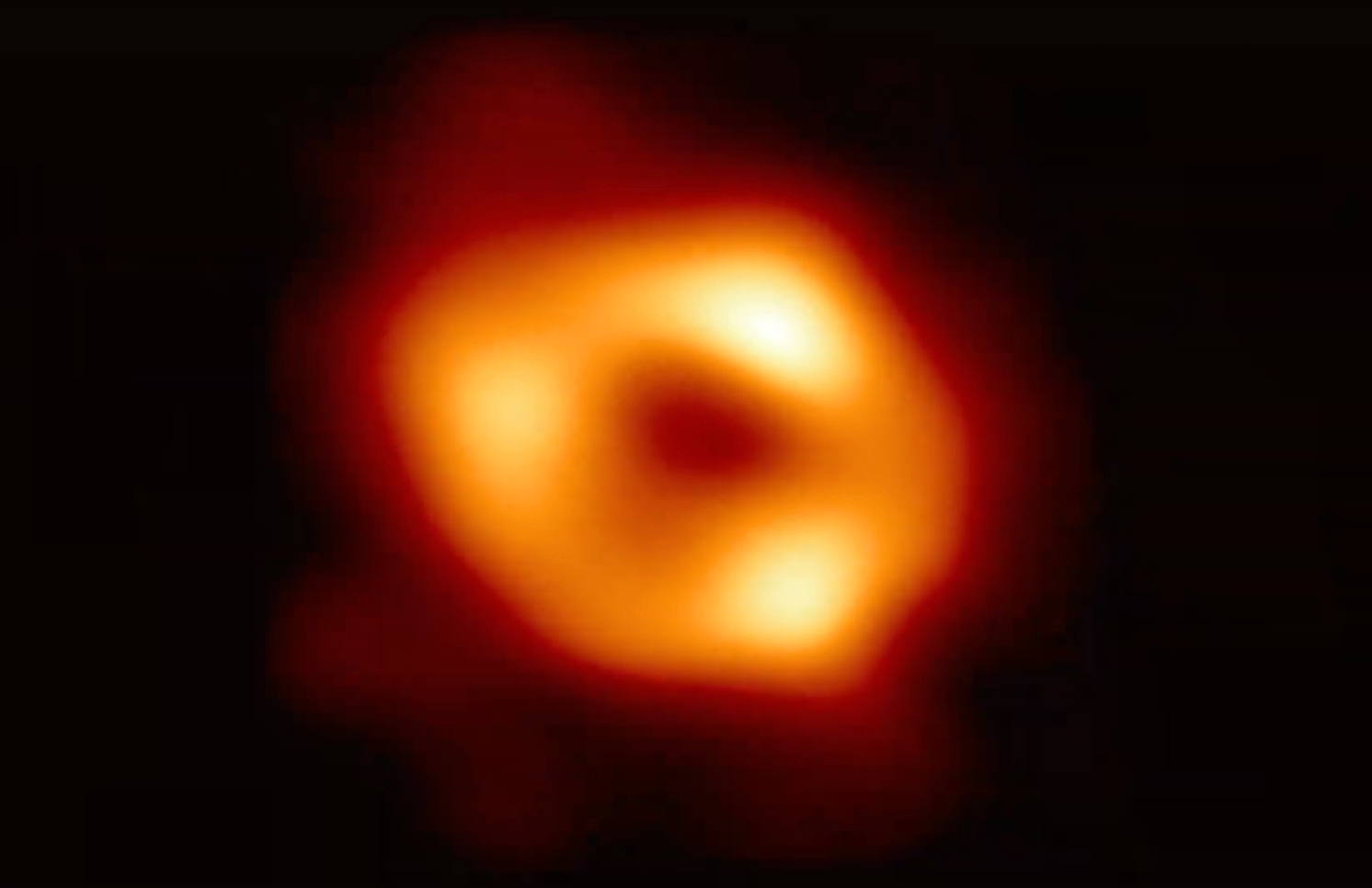 The supermassive black hole at the center of Sgr A*. (EHT Collaboration)
The supermassive black hole at the center of Sgr A*. (EHT Collaboration)
13.08: Oh wow, this is amazing. To be clear, we can't see the black hole itself – but it's there, in that dark patch in the middle of a disk of glowing material.
13.14: Sara Issaoun of Harvard is now speaking. We now, she says, for the first time, have direct evidence that Sgr A* is a black hole. The dark patch in the center is the shadow of the black hole; around it, hot gas swirls, heated by friction. This gas gives off radio radiation that we can detect.
Its size is about 52 microarcseconds in the sky, equivalent to imaging a donut on the Moon. Since the size of a black hole's shadow is related to its mass, we can use it to confirm that its mass is around 4 million times that of the Sun. This is exactly in agreement with Einstein's predictions from General Relativity!
Sgr A* looks very similar to the first image of a black hole ever obtained, that of M87*, even though the two are very different, and are in very different environments. This tells us that, no matter the size of the environment, the space around a black hole is going to be dominated by gravity.
13.17: Thomas Krichbaum of the Max Planck Institute for Radio Astronomy in Germany is now sharing the technical details of this tremendous achievement. It took 25 years to develop and refine the techniques to combine telescopes around the world into one giant, Earth-sized telescope that can achieve the resolution required to image black holes.
The result is an interferometer that is 3 million times sharper than the human eye. For the image of Sgr A*, six terabytes of data were obtained – analysis of this data took several years and required the development of new tools.
13.20: José L. Gómez of the Instituto de Astrofísica de Andalucía in Spain now tells us in greater detail how the eight telescopes of the Event Horizon Telescope work together to obtain observations.
Sgr A* was so much harder than M87*, though, he says. The region is obscured by dust; and, while the gas around each black hole moves at the same speed, Sgr A* is 1,500 times less massive, which means its gas has a much shorter orbit. This means that the gas was changing on rapid timescales while the observations were being taken.
13.23: This is the most thoroughly vetted interferometric image ever obtained, alongside the image of M87*.
HE HAS JUST PROMISED US MOVIES OF BLACK HOLES IN THE FUTURE.
13.25: Christian Fromm of Würzburg University in Germany is now stepping up to tell us what the image tells us about Sgr A*.
The team used supercomputers around the world to model black holes. When compared with their models, the image tells us that Sgr A* is rotating and that we are looking at it face-on.
13.27: Mariafelicia de Laurentis of the University of Naples "Federico II" and the National Institute for Nuclear Physics (INFN) in Italy tells us that the size of the shadow of Sgr A* is consistent with relativity, as with M87*, even though the two black holes are accreting materials at vastly different rates; Sgr A* a million times less than M87*.
13.29: Studying the environment around a black hole like Sgr A* or M87* will allow us to conduct new tests of general relativity, hoping to find places where it breaks down, says de Laurentis. This can help us try to understand gravity, as well as the role black holes play in our Universe. The best is yet to come!
13.31: This, says Anton Zensus in his closing remarks, is the next level. "We have combined the world's greatest radio telescopes into one Earth-sized camera."
The telescopes involved were:
- Atacama Large Millimeter/submillimeter Array (ALMA)
- the Atacama Pathfinder EXperiment (APEX) in the Atacama Desert in Chile
- the IRAM 30-meter telescope in Spain
- the James Clerk Maxwell Telescope (JCMT)
- the Large Millimeter Telescope Alfonso Serrano (LMT)
- the Submillimeter Array (SMA)
- the UArizona Submillimeter Telescope (SMT)
- the South Pole Telescope (SPT)
Since then, the EHT has added:
- the NOrthern Extended Millimeter Array (NOEMA) in France
- the Greenland Telescope (GLT)
- the UArizona 12-meter Telescope on Kitt Peak
13.35: None of this could have been possible without the 300 scientists who worked on this collaboration. "What about Einstein?," asks Zensus. "I rather think he would be ecstatic."
Okay, the press conference is flicking to a Q&A now, so we'll leave it there, but stay tuned for our full coverage
